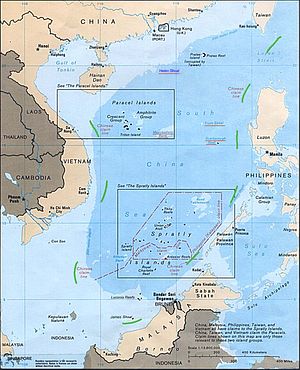New satellite imagery shows that China has started making improvements to at least one of the features under its control in the Paracel Islands in the South China Sea. Satellite imagery first reported by Reuters shows that Beijing has started conducting land reclamation work at North Island in the Paracels. Imagery first published by The Diplomat last year found that initial work at North Island likely began in late-2015.
A March 6 image of North Island shows “recent work including land clearing and possible preparation for a harbor to support what experts believe may be eventual military installations.” Earlier work on the island was damaged in a typhoon last year. Both Vietnam and Taiwan claim North Island.
Current work at North Island, as observable in satellite imagery, suggests that Beijing is planning the addition of a harbor facility. It’s unclear if China is planning to install point defenses at North Island as it has recently done on its Spratly possessions.
China is not the only South China Sea claimant state to militarize and carry out construction activities with potential military use on its holdings; Vietnam, the Philippines, Malaysia, and Taiwan have done so as well on their possessions. China’s work in recent years, however, has surpassed other claimants in ambition and pace.
The Chinese Defense Ministry has not commented on any construction or reclamation work at North Island, saying that it was “not familiar” with any such projects underway. “What needs to be stressed is that the Xisha Islands are China’s inherent territory,” the Chinese Defense Ministry said, according to Reuters. Xisha is the Chinese name for the Paracel group.
In recent years, China’s construction of seven artificial islands in the Spratly group in the South China Sea has drawn the most attention, but Beijing has historically seen the Paracels as a more robust strategic bastion in the disputed sea. Beijing’s largest possession in the entire South China Sea — Woody Island — is in the Paracels, for example
Not only does China position more than 1,400 full-time staff associated with the People’s Liberation Army on Woody Island, it has rotated advanced surface-to-air and anti-ship missile platforms to the island and also positions fighters there.
The Paracels thus form the anchor for China’s forward-leaning military presence inside the South China Sea, which is supported by Beijing’s broader military installations on the coast of Hainan Island.
Broadly speaking, between China’s possessions in the Spratlys and its more developed military presence in the Paracels, Beijing has ample space to project power in both the northern and southern reaches of the South China Sea. China has yet to carry out any land reclamation or island building work at Scarborough Shoal, located off the western coast of the Philippine island of Luzon, but early last year, the United States was concerned that Beijing may do so.
$5 trillion in international commerce passes through the South China Sea every year, where China, Vietnam the Philippines, Brunei, Malaysia, and Taiwan are mired in multiple disputes over island territory and maritime entitlements.

































